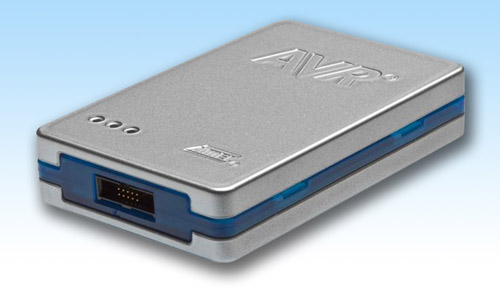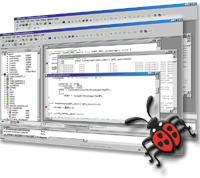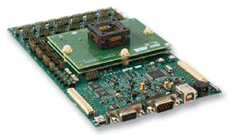| |
Products features and FAQ |
|
|
|
|
|
|
 |
Hardware Features of the JTAGICE mk3 |
|
|

|
- Fast USB Connection to the PC
-
Slower serial port interface also available
-
Connects to JTAG port of Target Microcontroller via 10-way IDC JTAG connector
-
Connects to DebugWIRE port of Target Microcontroller via the standard 6-way Atmel IDC Header
-
Interfaces to STK500 Board using a special connector board supplied with the JTAGICE
-
Interfaces to other JTAG targets using a special 'Squib Cable' which allows connection of each JTAG pin to a particular pin on the target device.
-
Can power either from the Target System or from an external Power Supply
|
 |
Programming / debug interfaces |
|
|
The JTAGICE mkII supports the following programming / debug interfaces:
- 4-wire JTAG Interface
- OneWire Debug Interface
- 2-wire PDI (Program and Debug Interface ) for Atmel XMEGA AVR microcontrollers
- 2-wire TPI (Tiny Programming Interface) for Atmel ATtiny AVR microcontrollers
|
 |
AVR Studio 4 - PC Driver Software |
|
|

Using AVR Studio 4 with the JTAGICE mkII Debugger, it is possible to single step, run to breakpoint or run until a certain data address is read or written. When reaching a breakpoint AVR Studio automatically reads out the contents of all memory locations, periperal functions like timers and USARTs and the state of the I/O ports.
Software features:
- Download code to the Target AVR FLASH CODE Memory
- Download data to the Target AVR EEPROM DATA Memory
- Set up to 4 Hardware Breakpoints in the code running on the real AVR device
- Set an unlimited number of Software Breakpoints in the code running on the real AVR device
- Single-step code on the real AVR device in real-time
- Run to breakpoint
- Read contents of all memory locations, periperal functions like timers and USARTs and the state of the I/O ports.
- Modify memory locations in FLASH / EEPROM
- Modify I/O ports from the PC
|
 |
What is the JTAG Interface ? |
|
|
The JTAG Interface was originally developed for In-Circuit Testing (ICT) of Integrated Circuits when mounted on a Circuit Board. The interface allows many IC's to be daisychained together to form a so-called 'JTAG Chain' which can be controlled from an external MASTER JTAG Test System. The MASTER on the JTAG Bus serially shifts test data through all the chips on the chain in order to test each device.
|
 |
Can the JTAG Interface be used for programming purposes ? |
|
|
Yes. The JTAG Interface supports very high-speed In-System Programming (ISP) of Atmel ATmega AVR devices making it an ideal method of programming virgin devices in a production environment. Any Equinox ISP Programmer can be upgraded to support high-speed JTAG ISP programming.
|
 |
What is the Atmel AVR JTAG implementation ? |
|
|
Atmel's JTAG implementation for AVR devices uses the JTAG Interface for high-speed debugging an programming purposes rather than for In-Circuit Testing. The JTAG Debugger e.g. JTAGICE or JTAG ISP Programmer e.g. Equinox PPM3-MK2 is the MASTER on the JTAG Bus and a single AVR device is the SLAVE i.e. there is only ONE device in the chain. This allows the JTAGICE / Programmer to support very high speed data transfer to the target AVR device via the JTAG interface. However, this method is not compatible with programming devices in a 'JTAG Chain'.
|
 |
Will the JTAGICE work with AVR devices in a JTAG chain ? |
|
|
No. The JTAGICE can only debug / program an AVR device when there is one device in the JTAG chain.
If your application demands programming of more than one AVR device in a chain, please contact Equinox for further information.
|
 |
What is the DebugWIRE Interface ? |
|
|
The 'debugWIRE Interface' allows In-System Debugging (ISD) through a single I/O pin of the AVR Microcontroller mounted on a Target Board. It is available on many of the newer low pin count ATmega and ATtiny AVR devices. The RESET pin of the target AVR chip is used for debugWIRE leaving all the other I/O pins free for the real target application.
|
 |
Alternative production programmers |
|
|
The JTAGICE mkII is ideal for use in a development environment where the there is no risk of Electrostatic Discharge (ESD), hot-swapping of Target Boards or different GROUND potentials. It is NOT designed for production use, has no effective I/O protection circuitry and cannot cope with target board hot-swapping.
If you require a programmer suitable for use in a production environment, please consider the Equinox range of production ISP programmers.
The range of Equinox ISP programmers includes....
- EPSILON5 - Portable Production ISP Programmer (1 x standalone projects)
- FS2009 - Portable Production ISP Programmer (64 x standalone projects)
- PPM4-MK1 - High-throughput Production ISP Programmer (64 x standalone projects)
- ISPnano Series 3 - High-throughput Production ISP Programmer for Test Fixtures (64 x standalone projects)
All the above programmers are capable of operating in 'Standalone Mode' (without PC control) making them ideal for production use.
See the 'Associated Products' list on the right-hand side of this page for further details.
|
 |
Compatible Evaluation Board (STK600) |
|
|

The Atmel AVR® STK600 is a complete starter kit and development system for the standard AVR, XMEGA AVR and AVR32 flash microcontrollers from ATMEL Corporation. It is designed to give designers a quick start to develop code on the AVR, combined with advanced features for using the starter kit to prototype and test new designs. STK600 is shipped with a ATmega2560 device board.
Socket and adapter boards are available for the whole range of AVR's, from 8- to 144-pins devices. The socket and adaptor boards must be bought separately.
Please see the 'Associated Products' section for further details.
|
| |